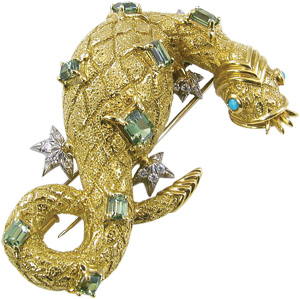|
Legacy
Bold Sold
Signed pieces and strong prices at the high and low ends were the hot trends at this year’s Miami Beach gathering of estate jewelry dealers.
By Phyllis Schiller
 |
| An 18-karat yellow gold, platinum, green tourmaline, diamond and turquoise Salamander brooch by Schlumberger, Tiffany & Co., circa 1990s. Photo courtesy Camilla Dietz Bergeron,Ltd. |
A go-to destination for estate jewelry buying and selling, the Original Miami Beach Antique Show once again provided a pulse-check for the dealers who made their annual trek to buy and sell, see and be seen.
The 54th edition of the show, held January 30 to February 3, had a banner opening day, the largest since 2008, with a 20 percent increase in attendance, and approximately 260 jewelry dealers exhibiting. “Everybody was really positive,” says Lisa Stockhammer-Mial, president of online retailer The Three Graces. “The event was very well attended. And it was nice to see what other people are looking for. The networking is invaluable.” Annette Brandt, A. Brandt & Son Antique and Estate Jewelry, Narberth, Pennsylvania, also appreciated the opportunity to meet people she does business with long distance in “a very comfortable venue.”
The size of the show makes it a “great mix” to hunt and find a broad range of merchandise, says Gus Davis, partner, Camilla Dietz Bergeron, Ltd., New York City. He did feel the weaker euro was a factor for European buyers. “I think quite a few Europeans didn’t come and the ones who did were quite cautious buyers.” But, he says, when it was “something very special and very unusual, there was no hesitation.”
Diana Singer, D&E Singer Inc., New York City, who says she had a great show, observed a “higher uptick” in Chinese buyers, who were looking at jade, amber and coral. “They’re hard bargainers, but if you have what they want, they buy.” Agrees Janet Levy, principal, J. & S.S. DeYoung Inc., New York City, “Most of the foreign buyers were looking for special items and they were willing to pay the price.”
The people who come to Miami are buyers, not just lookers, says Levy. But, she adds, it’s a “split market.” At the high end, the specialty pieces, “beautiful gemstones, signed pieces are all selling well.” And, she says, so are well-priced goods at the lower end that people can make money on. “But the middle-range — $10,000 to $30,000 — is very slow. A nice unsigned Art Deco bracelet priced well doesn’t seem to have any takers right now.”
“Everyone wishes for important, signed pieces — iconic Van Cleef, iconic Cartier, Tiffany,” says Davis. “The more unusual, rare things are what people are seeking.”
Eric Bitz, vice president of David & Company in Chestnut Hill, Massachusetts, says signed pieces are perennially popular. They were some of the first pieces that sold.
While all her signed jewelry sold, Singer notes that there is also a lot of unsigned jewelry that’s spectacular. “I wish people would look at a piece for its intrinsic design excellence and not just whether it has a signature or not.”
Singer says long diamond chains and long earrings were selling very, very well. Big and bold were on her shopping list. She says she made a point of buying dramatic pieces, like shoulder duster amethyst earrings. Davis reports he sold a beautiful platinum and diamond Art Deco necklace. “People want a signature piece that will make a statement.”
According to Bitz, the hot sellers were big diamonds — 5 carats-plus, finer qualities, both white and fancy colors — and fine emeralds, with more interest and strength in this segment than in the past. “Interest and demand, especially for bigger diamonds, were strong, and strong prices did not seem to discourage buyers.”
Colored gemstones attracted a lot of notice, Davis says. “Anything not heated is very much in fashion — unheated sapphires, rubies and emeralds, any fine stones.” Levy says she sold a fine Kashmir sapphire at the show as well as a pair of aquamarine earrings. She feels one of the advantages to colored stones is they fit into today’s more casual lifestyle. Stockhammer-Mial says there were a lot of “nice big, gemmy rings” and opal, amethyst, turquoise and coral jewelry.
Gold jewelry is still very, very strong, says Davis. Yellow gold also sold very well for Singer, which, she says, is a given every year. But this show she sold a lot more antique jewelry as well as very strong-looking 1940s and 1970s yellow gold jewelry.
Earrings were a hot category, as were rings. On Stockhammer-Mial’s radar were “both engagement rings and beautiful, gem-set or diamond rings that people buy just to wear.” She says her clients want “pretty, wearable jewelry.” Davis says easy-to-wear and versatile jewelry sells, like a beautiful long diamond chain. He notes that stacking and layering is still a big trend.
Stockhammer-Mial says stickpins and brooches, once a category buyers shied from, are selling because people are “repurposing them into rings and earrings and charms.” She explains to clients what the new piece originally was and says they appreciate the original workmanship in a more wearable option. Brandt, who says she sold mostly Victorian and Edwardian periods, also found people buying stickpins to convert into one-of-a-kind rings or pendants, something she also does for clients.
Singer feels the estate market is only going to thrive and expand in years to come. Levy also feels the sector is “healthy,” with the emphasis on uniqueness, quality and rarity, rather than just metal prices and exchange rates. “If the year follows the show,” sums up Bitz, “it should be a good one. If people are coming to Miami Beach willing to buy, it’s a sign that there’s strength in the market.”Article from the Rapaport Magazine - March 2015. To subscribe click here.
|
|